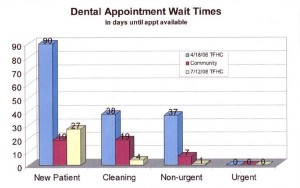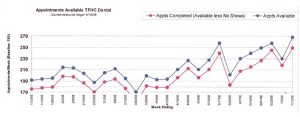The Toyota Health Care Story
Ford Brewer, the medical director for Toyota North American Health Care, describes what he needed to do to fund the development of the new Toyota Medical Clinic in San Antonio. “Since this expenditure was close to $9 million, I had to travel to Japan to justify it.” Toyota’s senior executives were not enamored with spending that kind of money on a health care clinic. At the same time, they also understood that healthcare costs were an important factor in the profitability decline of the Big Three U.s. automakers. In fact, Toyota officials had decided to build a new production facility in Canada due to the high cost of U.S. health care. In the end, the senior executive who agreed to the expenditure admitted that health care is extremely important to Toyota and therefore it’s important to experiment with innovative solutions to better manage it.
Toyota’s response is not unlike many forward thinking companies in the U.S. They are moving to managing the health care value stream in the same way they manage their supply value stream on the automotive side. The clinic that Dr. Brewer flew to Japan to get approved is actually not operated by Toyota. They have contracted with Take Care Inc., a subsidiary of Walgreen’s, to employ the physicians and nurses. A manager well-schooled in lean methodology is on board through Take Care to manage the staff the same way employees are managed across the street in the automobile shop.
In addition, Walgreen’s also runs the clinic’s onsite pharmacy, which fills around 70 percent of the prescriptions for the Toyota employees and their dependents. The employees are incented to come to the Toyota family health clinic by only having to pay a $5 co-pay for any visit to the primary care doctor and preventative visits to the dentist. Drugs also cost less and generic use is encouraged.
The clinic has just begun to use the Toyota principles in the redesign of their care. The dentistry clinic has worked hard to redesign the appointment process and roles and responsibilities of the staff. In just four months, they have reduced wait times for a new patient visit from 90 days to 27. There is much work to be done, but 13 work processes have been redesigned with standard work for the dental staff already. (Fig.1)

Toyota knows that the wait time, one of the eight wastes, is an important driver as to whether they will get their employees to utilize the clinic and compared to the dental community at large they still aren’t there yet. (Fig.2)

But they know what they have to do to get there and have begun to get a better handle on the total cost of dental care.
The medical clinic is just beginning to utilize lean tools to improve flow and access. There is a facilitator who has the job of gathering data and running TPS or Kaizen events in the clinic. He has measured many processes and has very specific task times identified for each of the caregivers. This is the staring point to begin to review variability with the primary care team and start to move to best practice within the clinic. At this point, they have already moved a few walls in the new clinic to improve flow and reduce waiting time. It proves that the process of patient flow should dictate design and environment rather than the other way around.
When Toyota gave the go ahead for this clinic, they negotiated with various national employer on-site clinic management companies. In a competitive bid process, Walgreen’s Take Care won. They had the best overall financial deal and had many clients that they were already working with proving to Toyota the site didn’t matter and they could manage their process in any community. In fact, the physicians hired were locally known and well respected. Some of the patients were already being cared for by the doctors that Take Care hired. Toyota signed a contract for Take Care to manage the clinic personnel with specific performance criteria that they would be held accountable for.
In addition they did the same with different health management companies to mange their physical therapy and wellness program and their dental program. The executives from these management companies meet with Toyota health officials regularly on site to discuss performance and strategically plan for the future.
After just one year in operation, Toyota is already seeing big pay back. A 33 percent reduction in specialty care costs and a 5 to 16 percent reduction in premium trend (depending on which model is used to determine community trend) are just two of the improvements noted. These changes were noted before TPS has even been started. The specialty care network has been narrowed significantly so that only 25 percent of the existing providers in the market have a contract with Toyota. They had to move away from their national insurance carrier and to a direct contract with local providers so that costs and quality could be measured and decisions could be made on network participation. The national network carrier was unable to administer the changes Dr. Brewer wanted.







